Yaowu Chen
Enhancing LLM's Cognition via Structurization
Jul 23, 2024



Abstract:When reading long-form text, human cognition is complex and structurized. While large language models (LLMs) process input contexts through a causal and sequential perspective, this approach can potentially limit their ability to handle intricate and complex inputs effectively. To enhance LLM's cognition capability, this paper presents a novel concept of context structurization. Specifically, we transform the plain, unordered contextual sentences into well-ordered and hierarchically structurized elements. By doing so, LLMs can better grasp intricate and extended contexts through precise attention and information-seeking along the organized structures. Extensive evaluations are conducted across various model architectures and sizes (including several 7B- to 72B-size auto-regressive LLMs as well as BERT-like masking models) on a diverse set of NLP tasks (e.g., context-based question-answering, exhaustive hallucination evaluation, and passage-level dense retrieval). Empirical results show consistent and significant performance gains afforded by a single-round structurization. In particular, we boost a 72B-parameter open-source model to achieve comparable performance against GPT-3.5-Turbo as the hallucination evaluator. Besides, we show the feasibility of distilling advanced LLMs' language processing abilities to a smaller yet effective StruXGPT-7B to execute structurization, addressing the practicality of our approach. Code will be made public soon.
Educating LLMs like Human Students: Structure-aware Injection of Domain Knowledge
Jul 23, 2024



Abstract:This paper presents a pioneering methodology, termed StructTuning, to efficiently transform foundation Large Language Models (LLMs) into domain specialists. It significantly minimizes the training corpus requirement to a mere 0.3% while achieving an impressive 50% of traditional knowledge injection performance. Our method is inspired by the educational processes for human students, particularly how structured domain knowledge from textbooks is absorbed and then applied to tackle real-world challenges through specific exercises. Based on this, we propose a novel two-stage knowledge injection strategy: Structure-aware Continual Pre-Training (SCPT) and Structure-aware Supervised Fine-Tuning (SSFT). In the SCPT phase, we organize the training data into an auto-generated taxonomy of domain knowledge, enabling LLMs to effectively memorize textual segments linked to specific expertise within the taxonomy's architecture. Subsequently, in the SSFT phase, we explicitly prompt models to reveal the underlying knowledge structure in their outputs, leveraging this structured domain insight to address practical problems adeptly. Our ultimate method has undergone extensive evaluations across model architectures and scales, using closed-book question-answering tasks on LongBench and MMedBench datasets. Remarkably, our method matches 50% of the improvement displayed by the state-of-the-art MMedLM2 on MMedBench, but with only 0.3% quantity of the training corpus. This breakthrough showcases the potential to scale up our StructTuning for stronger domain-specific LLMs. Code will be made public soon.
Rethinking Out-of-Distribution Detection on Imbalanced Data Distribution
Jul 23, 2024Abstract:Detecting and rejecting unknown out-of-distribution (OOD) samples is critical for deployed neural networks to void unreliable predictions. In real-world scenarios, however, the efficacy of existing OOD detection methods is often impeded by the inherent imbalance of in-distribution (ID) data, which causes significant performance decline. Through statistical observations, we have identified two common challenges faced by different OOD detectors: misidentifying tail class ID samples as OOD, while erroneously predicting OOD samples as head class from ID. To explain this phenomenon, we introduce a generalized statistical framework, termed ImOOD, to formulate the OOD detection problem on imbalanced data distribution. Consequently, the theoretical analysis reveals that there exists a class-aware bias item between balanced and imbalanced OOD detection, which contributes to the performance gap. Building upon this finding, we present a unified training-time regularization technique to mitigate the bias and boost imbalanced OOD detectors across architecture designs. Our theoretically grounded method translates into consistent improvements on the representative CIFAR10-LT, CIFAR100-LT, and ImageNet-LT benchmarks against several state-of-the-art OOD detection approaches. Code will be made public soon.
ESOD: Efficient Small Object Detection on High-Resolution Images
Jul 23, 2024



Abstract:Enlarging input images is a straightforward and effective approach to promote small object detection. However, simple image enlargement is significantly expensive on both computations and GPU memory. In fact, small objects are usually sparsely distributed and locally clustered. Therefore, massive feature extraction computations are wasted on the non-target background area of images. Recent works have tried to pick out target-containing regions using an extra network and perform conventional object detection, but the newly introduced computation limits their final performance. In this paper, we propose to reuse the detector's backbone to conduct feature-level object-seeking and patch-slicing, which can avoid redundant feature extraction and reduce the computation cost. Incorporating a sparse detection head, we are able to detect small objects on high-resolution inputs (e.g., 1080P or larger) for superior performance. The resulting Efficient Small Object Detection (ESOD) approach is a generic framework, which can be applied to both CNN- and ViT-based detectors to save the computation and GPU memory costs. Extensive experiments demonstrate the efficacy and efficiency of our method. In particular, our method consistently surpasses the SOTA detectors by a large margin (e.g., 8% gains on AP) on the representative VisDrone, UAVDT, and TinyPerson datasets. Code will be made public soon.
URRL-IMVC: Unified and Robust Representation Learning for Incomplete Multi-View Clustering
Jul 12, 2024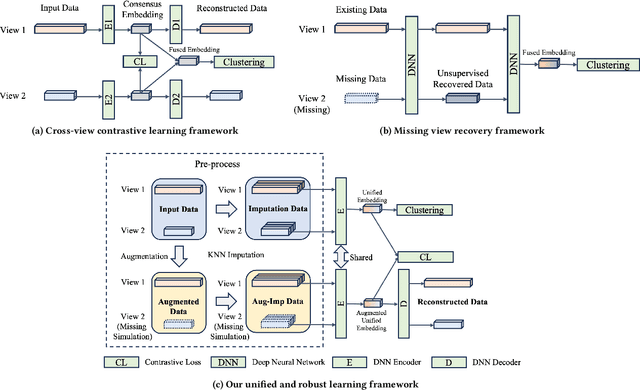

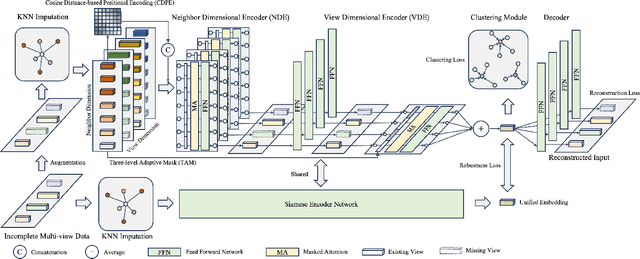
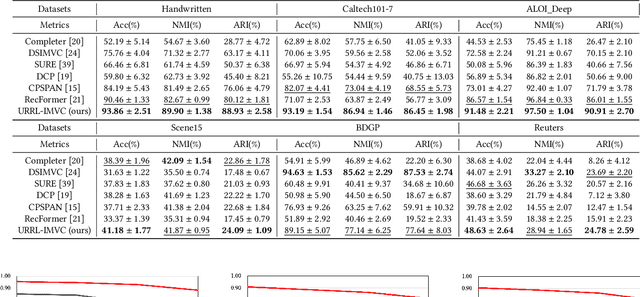
Abstract:Incomplete multi-view clustering (IMVC) aims to cluster multi-view data that are only partially available. This poses two main challenges: effectively leveraging multi-view information and mitigating the impact of missing views. Prevailing solutions employ cross-view contrastive learning and missing view recovery techniques. However, they either neglect valuable complementary information by focusing only on consensus between views or provide unreliable recovered views due to the absence of supervision. To address these limitations, we propose a novel Unified and Robust Representation Learning for Incomplete Multi-View Clustering (URRL-IMVC). URRL-IMVC directly learns a unified embedding that is robust to view missing conditions by integrating information from multiple views and neighboring samples. Firstly, to overcome the limitations of cross-view contrastive learning, URRL-IMVC incorporates an attention-based auto-encoder framework to fuse multi-view information and generate unified embeddings. Secondly, URRL-IMVC directly enhances the robustness of the unified embedding against view-missing conditions through KNN imputation and data augmentation techniques, eliminating the need for explicit missing view recovery. Finally, incremental improvements are introduced to further enhance the overall performance, such as the Clustering Module and the customization of the Encoder. We extensively evaluate the proposed URRL-IMVC framework on various benchmark datasets, demonstrating its state-of-the-art performance. Furthermore, comprehensive ablation studies are performed to validate the effectiveness of our design.
Self-Learning Symmetric Multi-view Probabilistic Clustering
May 12, 2023



Abstract:Multi-view Clustering (MVC) has achieved significant progress, with many efforts dedicated to learn knowledge from multiple views. However, most existing methods are either not applicable or require additional steps for incomplete multi-view clustering. Such a limitation results in poor-quality clustering performance and poor missing view adaptation. Besides, noise or outliers might significantly degrade the overall clustering performance, which are not handled well by most existing methods. Moreover, category information is required in most existing methods, which severely affects the clustering performance. In this paper, we propose a novel unified framework for incomplete and complete MVC named self-learning symmetric multi-view probabilistic clustering (SLS-MPC). SLS-MPC proposes a novel symmetric multi-view probability estimation and equivalently transforms multi-view pairwise posterior matching probability into composition of each view's individual distribution, which tolerates data missing and might extend to any number of views. Then, SLS-MPC proposes a novel self-learning probability function without any prior knowledge and hyper-parameters to learn each view's individual distribution from the aspect of consistency in single-view, cross-view and multi-view. Next, graph-context-aware refinement with path propagation and co-neighbor propagation is used to refine pairwise probability, which alleviates the impact of noise and outliers. Finally, SLS-MPC proposes a probabilistic clustering algorithm to adjust clustering assignments by maximizing the joint probability iteratively, in which category information is not required. Extensive experiments on multiple benchmarks for incomplete and complete MVC show that SLS-MPC significantly outperforms previous state-of-the-art methods.
Information-containing Adversarial Perturbation for Combating Facial Manipulation Systems
Mar 21, 2023



Abstract:With the development of deep learning technology, the facial manipulation system has become powerful and easy to use. Such systems can modify the attributes of the given facial images, such as hair color, gender, and age. Malicious applications of such systems pose a serious threat to individuals' privacy and reputation. Existing studies have proposed various approaches to protect images against facial manipulations. Passive defense methods aim to detect whether the face is real or fake, which works for posterior forensics but can not prevent malicious manipulation. Initiative defense methods protect images upfront by injecting adversarial perturbations into images to disrupt facial manipulation systems but can not identify whether the image is fake. To address the limitation of existing methods, we propose a novel two-tier protection method named Information-containing Adversarial Perturbation (IAP), which provides more comprehensive protection for {facial images}. We use an encoder to map a facial image and its identity message to a cross-model adversarial example which can disrupt multiple facial manipulation systems to achieve initiative protection. Recovering the message in adversarial examples with a decoder serves passive protection, contributing to provenance tracking and fake image detection. We introduce a feature-level correlation measurement that is more suitable to measure the difference between the facial images than the commonly used mean squared error. Moreover, we propose a spectral diffusion method to spread messages to different frequency channels, thereby improving the robustness of the message against facial manipulation. Extensive experimental results demonstrate that our proposed IAP can recover the messages from the adversarial examples with high average accuracy and effectively disrupt the facial manipulation systems.
Rethinking Out-of-Distribution Detection From a Human-Centric Perspective
Nov 30, 2022



Abstract:Out-Of-Distribution (OOD) detection has received broad attention over the years, aiming to ensure the reliability and safety of deep neural networks (DNNs) in real-world scenarios by rejecting incorrect predictions. However, we notice a discrepancy between the conventional evaluation vs. the essential purpose of OOD detection. On the one hand, the conventional evaluation exclusively considers risks caused by label-space distribution shifts while ignoring the risks from input-space distribution shifts. On the other hand, the conventional evaluation reward detection methods for not rejecting the misclassified image in the validation dataset. However, the misclassified image can also cause risks and should be rejected. We appeal to rethink OOD detection from a human-centric perspective, that a proper detection method should reject the case that the deep model's prediction mismatches the human expectations and adopt the case that the deep model's prediction meets the human expectations. We propose a human-centric evaluation and conduct extensive experiments on 45 classifiers and 8 test datasets. We find that the simple baseline OOD detection method can achieve comparable and even better performance than the recently proposed methods, which means that the development in OOD detection in the past years may be overestimated. Additionally, our experiments demonstrate that model selection is non-trivial for OOD detection and should be considered as an integral of the proposed method, which differs from the claim in existing works that proposed methods are universal across different models.
Towards Understanding and Boosting Adversarial Transferability from a Distribution Perspective
Oct 09, 2022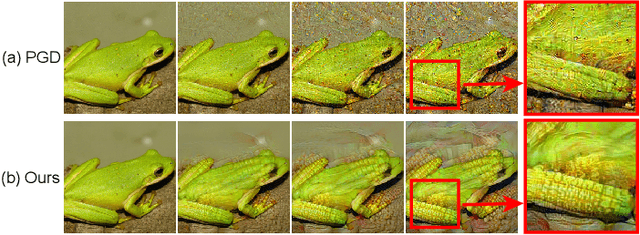
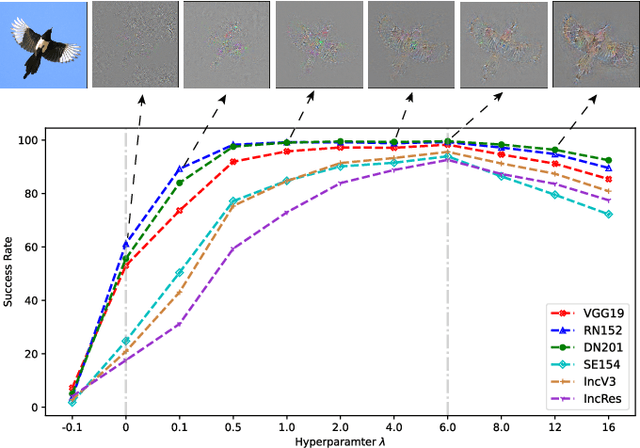


Abstract:Transferable adversarial attacks against Deep neural networks (DNNs) have received broad attention in recent years. An adversarial example can be crafted by a surrogate model and then attack the unknown target model successfully, which brings a severe threat to DNNs. The exact underlying reasons for the transferability are still not completely understood. Previous work mostly explores the causes from the model perspective, e.g., decision boundary, model architecture, and model capacity. adversarial attacks against Deep neural networks (DNNs) have received broad attention in recent years. An adversarial example can be crafted by a surrogate model and then attack the unknown target model successfully, which brings a severe threat to DNNs. The exact underlying reasons for the transferability are still not completely understood. Previous work mostly explores the causes from the model perspective. Here, we investigate the transferability from the data distribution perspective and hypothesize that pushing the image away from its original distribution can enhance the adversarial transferability. To be specific, moving the image out of its original distribution makes different models hardly classify the image correctly, which benefits the untargeted attack, and dragging the image into the target distribution misleads the models to classify the image as the target class, which benefits the targeted attack. Towards this end, we propose a novel method that crafts adversarial examples by manipulating the distribution of the image. We conduct comprehensive transferable attacks against multiple DNNs to demonstrate the effectiveness of the proposed method. Our method can significantly improve the transferability of the crafted attacks and achieves state-of-the-art performance in both untargeted and targeted scenarios, surpassing the previous best method by up to 40$\%$ in some cases.
Boosting Out-of-distribution Detection with Typical Features
Oct 09, 2022
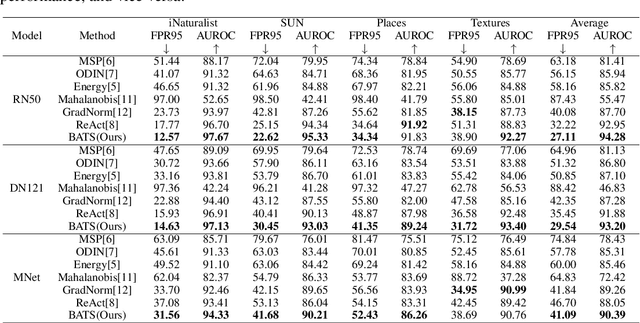

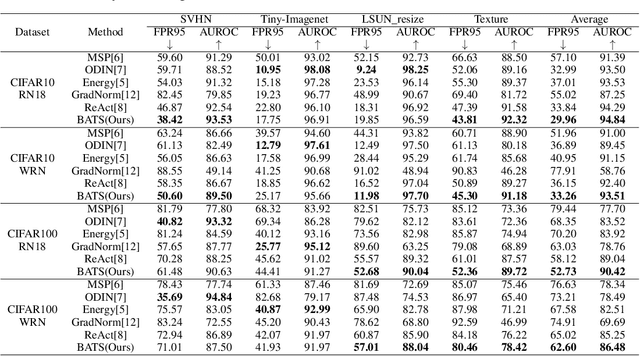
Abstract:Out-of-distribution (OOD) detection is a critical task for ensuring the reliability and safety of deep neural networks in real-world scenarios. Different from most previous OOD detection methods that focus on designing OOD scores or introducing diverse outlier examples to retrain the model, we delve into the obstacle factors in OOD detection from the perspective of typicality and regard the feature's high-probability region of the deep model as the feature's typical set. We propose to rectify the feature into its typical set and calculate the OOD score with the typical features to achieve reliable uncertainty estimation. The feature rectification can be conducted as a {plug-and-play} module with various OOD scores. We evaluate the superiority of our method on both the commonly used benchmark (CIFAR) and the more challenging high-resolution benchmark with large label space (ImageNet). Notably, our approach outperforms state-of-the-art methods by up to 5.11$\%$ in the average FPR95 on the ImageNet benchmark.
 Add to Chrome
Add to Chrome Add to Firefox
Add to Firefox Add to Edge
Add to Edge